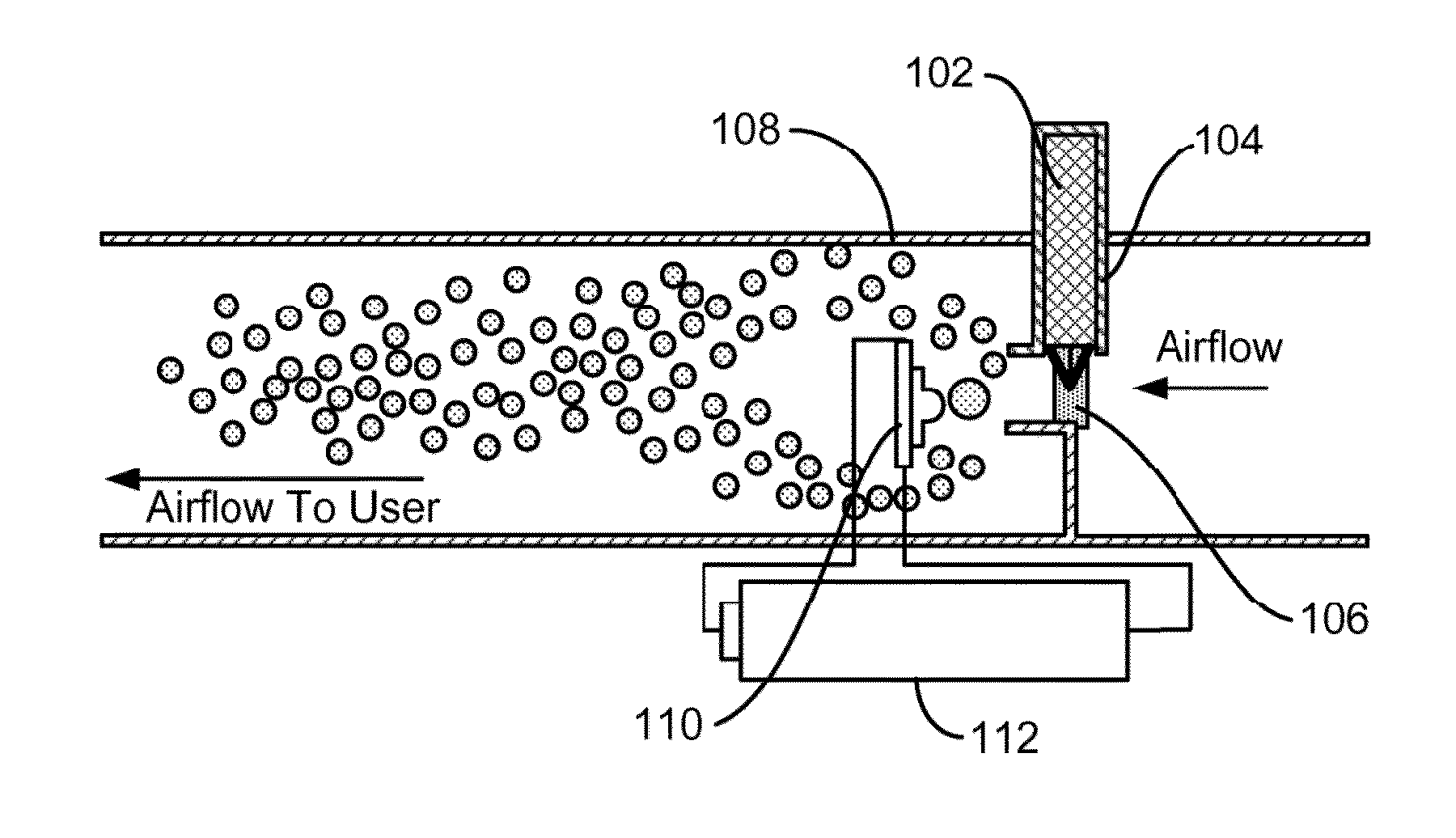Methods and devices for smoking urge relief
a technology of urge relief and methods, applied in the direction of ict adaptation, tobacco, respirator, etc., can solve the problems of lapse, eventual relapse, and ineffectiveness of current nicotine replacement therapies (nrts), so as to reduce the urge, and reduce the urge to smoke
- Summary
- Abstract
- Description
- Claims
- Application Information
AI Technical Summary
Benefits of technology
Problems solved by technology
Method used
Image
Examples
example 1
Effect of Changes in Air Flow Rate, Electrical Current, Duration of Heating, and Thickness of Heater Element on Particle Size of a Aerosol Generated from a Propylene Glycol Formulation
[0422]This example describes how changes in specific parameters (i.e. air flow rate, electrical current to a heater element, and thickness of a heater element) affected the size of aerosol particles generated by a test apparatus designed to comprise components and / or parameters of a nicotine delivery device as described herein. FIG. 26 shows a schematic of the entire test apparatus while FIGS. 27A-D shows alternate views of the test airway used in the test apparatus. The test bed had an airway created between a block of Delrin (bottom) and a sheet of clear plexiglass (top) with brass sides used to clamp and make electrical contact with a heater element. The heater element was a stainless steel foil of variable thickness (0.0005 inches (about 0.013 mm) or 0.001 inches (about 0.025 mm)), and the formulat...
example 2
Effect of Changes in Air Flow Rate, Electrical Current, Duration of Heating, and Thickness of Heater Element on Particle Size of an Aerosol Generated from a Nicotine / Propylene Glycol Formulation
[0423]This example describes how changes in specific parameters (i.e. air flow rate, and electrical current to a heater element) affected the size of aerosol particles generated from a 10% nicotine / propylene glycol formulation by a test apparatus as described in Example 1. Table 3 shows the results of altering heater element thickness, air flow rate, current, and duration of heating on particle size distribution. As shown in Table 3, when air flow rate was altered while other parameters were held constant, the higher the air flow rate, the smaller the average particle size diameter (PSD).
TABLE 3Nicotine / propylene glycol mixture (10%) aerosol data from test airwayHeater ElementAir FlowDurationAverage ParticleThicknessRateDoseCurrentof HeatingSize DiameterSequenceMaterial(inches)(Liters / min)(mg...
example 3
Particle Size Diameter Ranges of Aerosols Generated from a Test Apparatus Using a Heater Element Comprising a Wire Coil
[0424]This example describes the particle size diameters of aerosols generated from either a PG formulation or 10% nicotine / PG formulation using a test apparatus as shown in FIGS. 26 and 27A-D and described in Example 1. In this example, the heater element was a stainless steel coil comprising 3.5 coils and a diameter of 0.10 inches (about 2.54 mm). The heater element was heated using a current of 2.5 Amps and the air flow rate was 4 Liters / min (about 6.7×10−5 m3 / s). Table 4 shows the results.
TABLE 4Air FlowParticleRateDurationSize(Liters / DoseCurrentof HeatingDiameterSequenceMaterialmin)(mg)(Amps)(seconds)(microns)1PG412.511.5-2.22PG412.511.5-2.23Nic / PG412.511.57-2.2 4Nic / PG212.511.6-2.85Nic / PG212.511.52-2.2 6PG212.511.5-2.27PG412.511.5-2.38PG412.512.4-1.5
PUM
 Login to View More
Login to View More Abstract
Description
Claims
Application Information
 Login to View More
Login to View More - Generate Ideas
- Intellectual Property
- Life Sciences
- Materials
- Tech Scout
- Unparalleled Data Quality
- Higher Quality Content
- 60% Fewer Hallucinations
Browse by: Latest US Patents, China's latest patents, Technical Efficacy Thesaurus, Application Domain, Technology Topic, Popular Technical Reports.
© 2025 PatSnap. All rights reserved.Legal|Privacy policy|Modern Slavery Act Transparency Statement|Sitemap|About US| Contact US: help@patsnap.com



